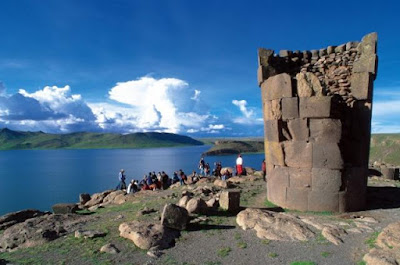villages of Puno: Juliaca, Juli, Chucuito, Pomata, Pucara, Ayaviri, Azángaro and Lampa
JULIACA, Puno Mall
It is the commercial centre of Puno, headquarters of the airport and knot of the railway network that links Puno, Cusco, and Arequipa. An old phrase says: "while Puno dance, Juliaca advances" and thus seems to be when one visits this bustling and chaotic city, full of shops and markets. Visit the temples of La Merced and Santa Catalina towers, as well as the Franciscan convent, beautiful works of colonial architecture. Near the village are the chullpas de Samayoa and Chacas lagoon, which has thermal waters.3.824 masl. 45 km N of Puno (1 h)
CHUCHUITO and the Temple of the phalluses
This village was the center of tax collection during the colony. This village still conserves part of its original construction, stone houses, arches with inscribed monograms and some carved lintels.Its central square retains a sundial made in Alabaster white or stone of Huamanga, which was used for punishment during the Holy Inquisition. On its side, is the Ceremonial Inca Uyo Temple, also called "' temple of the penises", a venue that has between twenty and thirty Phalluses in the soil. It is believed that you served as guidance for the seasons of the year and a ceremonial center of fertility.
They include the Santo Domingo Temple, built in 1581, whose Atrium functions as a cemetery, and the Church of the assumption (1555-57), of Renaissance style that retains a wonderful Silver altar. Altitude: 3.793 masl. Distance 16 km (30 min) to the will of Puno
JULI the Rome of America
The village has four competing in beauty and temples that have earned him the nickname of "the Rome of America". The most famous Temple is San Pedro, of Renaissance style. The San Juan de Letran has a nave of large proportions and stands out for the cover of the sacristy, carved from dark stone. The Jesuit church of Santa Cruz is notable for its cover of three bodies, crowned by the monogram of the order, and supported by Corinthian columns, although it is in a bad state of conservation. Finally there is the assumption, which is in ruins, although it retains part of its lateral façade and a tower.Altitude: 3.870 masl. Distance: 80 km (1 h) to the will of Puno
POMATA, the viewpoints of Pomata
He is known as the "balcony philosophical of the plateau", by their viewpoints. In this village stands the Temple of Santiago Apóstol, dating from 1756, an exquisite mestizo style, built in red stone. Its Renaissance style porch is decorated with fruits and flowers. From Pomata outputs to Yunguyo, 22 km to the South, near the border with Bolivia, can be arranged in the Strait of Tiquina.Altitude: 3.845 masl. Distance: 104 km (1 h 15 min) to the will of Puno
LAMPA the Pink City
Known as the "Pink City", by clay that colors their houses, it is one of the most beautiful towns of the Andean South of the Peru. Among the many attractions of the city it stands out its spectacular colonial church Santiago Apóstol and its catacombs, built entirely in stone between 1675 and 1685. The temple keeps a beautiful replica of La Piedad, Miguel Angel. There is also his mausoleum, decorated with a thousand skulls and skeletons 37.Altitude: 3,842 meters above sea level. Distance: 35 km NW of Juliaca (45 min)
Pucara and its famous bulls of Pucara
This town is famous for its "toritos de Pucara" (artisan pieces of religious magic) which are delivered during the feast of branding cattle or senalacuy. Interestingly, these crafts do not occur in Pucara, but in the village of Pupuja, 15 km away. The bulls named Pucara because they were sold at the railway station of this town, which became famous. The Citadel of Kalasaya, of origin pucara is located close-by and later inhabited by the Tiahuanaco. You can also visit the Pucara lithic Museum, which exhibits monoliths, stele and Zoomorphic sculptures.Altitude: 3,996 masl. Distance: 107 km (1 h 30 min) n of Puno
AZÁNGARO and the Golden Temple
This visit can be completed with stops in Pucara and Pupuja. Here we can see the famous Golden Temple, one of the most beautiful of the Andes, which has a collection of paintings by Francisco de Moncada, in 1758. You can also visit the lagoon of La Calzada, the chullpas of Paucarpata and Catahuicucho platforms. To reach Azangaro take a partially paved road towards the N0.Altitude: 3,859 metres above sea level. Distance: 130 km (1 h 30 min) n of Puno
TINAJANI STONE FOREST
The 100 has that make up the forest of Tinajani possess dozens of whimsical formations made of a reddish stone. Among these rocks there is also an interesting natural life: grow bushes and there is water where alpacas and vicuñas come to drink. Emphasizes rock called El Vigia, 93 m of height. Tinajani is country to country
Villages of puno
4/
5
Oleh
jhuapayac

